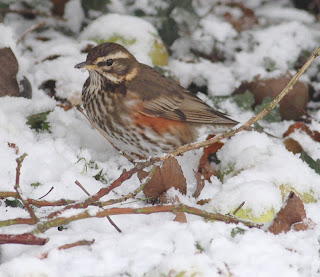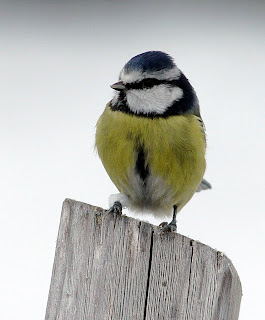It was about minus 10 or 12 degrees this morning, ice on top of layers of frost and hard-packed snow. Not the best weather for driving down some of the out-of-the-way lanes that birders like to go, but the sun was up and after yesterday I needed fresh air. I negotiated slippy, Smithy Lane, where gritting wagons never venture, reached the main road without mishap then headed towards Lane Ends. At the junction of Wheel Lane by the stubble fields 15 Fieldfare and 6 Redwing vied with a couple of Blackbirds for the remaining hawthorn berries, skitting across the road as my approaching car crunched noisily over the ice and snow - not easy trying to use the car as a hide today.
Approximately 130 Whooper Swans were in the field, merged into the white backdrop, waiting for the strong sun and their paddling about to thaw the icy flash. They came and went quickly to head just inland, out of sight where they have another refuge. Once I got to Lane Ends I revised my count to a combined 265 Whoopers as there were more of them on the distant marsh, some halfway to Cockersands so far away were they.


Lane Ends was bitterly cold and unsurprisingly, no one there apart from a second insane family birder, another PS braving the elements. I left him scanning the marsh and headed off to Pilling Water for a warming walk even though I didn’t expect to see a lot.
At the outflow ditch that is the famous water I found 8 Skylark, 350 Teal, 120 Wigeon, 8 Shelduck, 400 Mallard and a Reed Bunting gamely hanging on. The cold weather has made tighter flocks of Jackdaws, and I counted a noisy 450 between the water and Fluke Hall where they make the most of leftovers from the shooter’s wildfowl food. The duck were pretty active, mainly because of a Peregrine that flew at them a couple of times without success before it went out to the edge of the marsh. On the way back to Lane Ends I watched a single Kestrel hunt the fence line ahead of me, but both frozen pools and the woodland were deserted apart from a few Blackbirds and now semi-tame Woodpigeon, so that was about it for my meagre efforts.
At home I dug out more apples from the freezer, blitzed them in the microwave then chopped them up with a hoe in a quarter-bucket of bird seed and fat balls. The birds enjoyed the mixture and I hope it helps a few more survive the promise of continued cold weather. Here are a few more pictures of birds in the snow and ice. When we take the time and trouble to look, aren’t garden birds just ace?
























































.jpeg)




.jpg)













